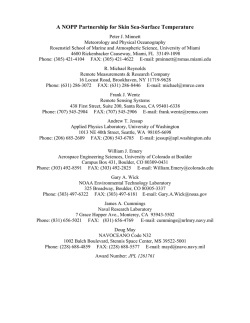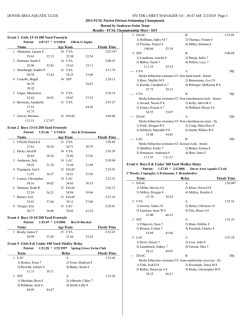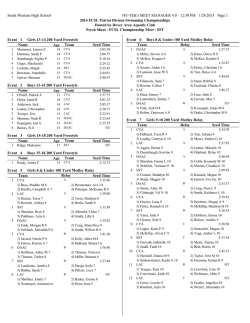
06: A NOPP Partnership for Skin Sea
A NOPP Partnership for Skin Sea-Surface Temperature Peter J. Minnett Meteorology and Physical Oceanography Rosenstiel School of Marine and Atmospheric Science, University of Miami 4600 Rickenbacker Causeway, Miami, FL 33149-1098 Phone: (305) 421-4104 FAX: (305) 421-4622 E-mail: [email protected] R. Michael Reynolds Remote Measurements & Research Company 16 Locust Road, Brookhaven, NY 11719-9628 Phone: (631) 286-3072 FAX: (631) 286-8446 E-mail: [email protected] Frank J. Wentz Remote Sensing Systems 438 First Street, Suite 200, Santa Rosa, CA 95401-6338 Phone: (707) 545-2904 FAX: (707) 545-2906 E-mail: [email protected] Andrew T. Jessup Applied Physics Laboratory, University of Washington 1013 NE 40th Street, Seattle, WA 98105-6698 Phone: (206) 685-2609 FAX: (206) 543-6785 E-mail: [email protected] William J. Emery Aerospace Engineering Sciences, University of Colorado at Boulder Campus Box 431, Boulder, CO 80309-0431 Phone: (303) 492-8591 FAX: (303) 492-2825 E-mail: [email protected] Gary A. Wick NOAA Environmental Technology Laboratory 325 Broadway, Boulder, CO 80305-3337 Phone: (303) 497-6322 FAX: (303) 497-6181 E-mail: [email protected] James A. Cummings Naval Research Laboratory 7 Grace Hopper Ave., Monterey, CA 93943-5502 Phone: (831) 656-5021 FAX: (831) 656-4769 E-mail: [email protected] Doug May NAVOCEANO Code N32 1002 Balch Boulevard, Stennis Space Center, MS 39522-5001 Phone: (228) 688-4859 FAX: (228) 688-5577 E-mail: [email protected] Award Number: JPL 1261761 LONG-TERM GOALS Sea surface temperature (SST) is an important parameter in many operational and research activities, ranging from weather forecasting to climate research. The goals of this project are to demonstrate the use of autonomous infrared radiometers that measure the skin SST to absolute accuracies that are useful for the validation of global SST fields derived from measurements on earth-observation satellites, to use these measurements to determine the accuracies of such remotely-sensed SSTs, and to demonstrate the use of skin SSTs in forecast models. OBJECTIVES As a result of the heat flow between the ocean and overlying atmosphere, the surface of the ocean is nearly always somewhat cooler than the water at a depth of a millimeter or more. The temperature difference across the thermal conductive layer at the sea surface is usually referred to as the skin effect the surface is called the thermal skin effect. During the day, solar heating may cause vertical temperature gradient in the uppermost several meters of the ocean, especially in conditions of low wind speed, which further decouple the bulk “SSTs,” conventionally measured by thermometers at a depth of a meter or so, from the skin SST, which is the temperature that controls the exchange of heat, momentum and gases between the ocean and atmosphere. Furthermore, it is the skin temperature that gives rise to the signal measured by space-borne radiometers. Thus, the uncertainties in the satellitederived SST fields determined by comparisons with sub-surface bulk temperature include a component due to the variability in the temperature gradients in the upper few meters, and across the skin layer. The objectives are to provide accurate skin SSTs using autonomous radiometers, to establish the accuracies of satellite-derived skin SSTs, and to demonstrate the changes, hopefully improvements, in the coupling between ocean and atmosphere in forecast models, and process models that help us understand the physical behavior of the skin layer. APPROACH AND WORK PLAN The approach has been to adopt the Infrared Scanning Autonomous Radiometer (ISAR; Donlon et al., 2007) and the Calibrated InfraRed In situ Measurement System (CIRIMS; Jessup et al., 2002; Jessup and Branch, 2007) as the autonomous radiometers for use in this project. The ISAR was developed at the National Oceanography Centre (NOC), Southampton, UK, and CIRIMS at the Applied Physics Laboratory at the University of Washington, Seattle. The absolute accuracy of the two sets of radiometers is established by at-sea comparisons with the at-sea measurements of the MarineAtmospheric Emitted Radiance Interferometer (M-AERI; Minnett et al., 2001). The skin SST measurements are used to determine the accuracy of the SSTs derived from the infrared bands of MODerate-resolution Imaging Spectrometer (MODIS) on the NASA EOS Terra and Aqua Satellites, and of the microwave measurements of the TRMM (Tropical Rainfall Measuring Mission) Microwave Radiometer (TMI), and the Advanced Microwave Scanning Radiometer for EOS (AMSR-E) on Aqua. In addition, skin SST measurements are made available to European colleagues for the validation of the Advanced Along-Track Scanning Radiometer (AATSR) on Envisat. Studies using the skin SST measurements, together with theoretical models, are undertaken to determine improved parameterizations of the skin effect for inclusion in models, and the consequences of using skin SST, as opposed to bulk SST, in process models focused on differences between skin and bulk SSTs are being used. The key individuals leading the various components of the project are given in Table 1. Table 1: Major partners and their roles in this project. Partner Roles and Tasks P. J. Minnett University of Miami R. M. Reynolds Remote Measurements & Research Co. A. T. Jessup APL - University of Washington F. Wentz Remote Sensing Systems W. J. Emery University of Colorado G. A. Wick NOAA-ETL J. Cummings NRL Monterey D. May NAVOCEANO Project lead, M-AERI deployments, absolute calibrations of sensors, AVHRR and MODIS analyses Instrument integration, at-sea deployments Instrument calibration, at-sea deployments Microwave SSTs Bulk-skin models, regression skin SST analysis Near-surface temperature models, GOES SST analysis Application of skin SST to atmospheric forecast models Operational applications WORK COMPLETED The first ISAR (ISAR-01) was deployed on the NYK ship, the car-transporter Jingu Maru, on July 9, 2005. The Jingu Maru sailed between northern European ports and those on the US Eastern Seaboard on a regular basis. The data were transmitted via Inmarsat-C on an hourly basis to Miami and distributed to the interested partners by email. Following quality control, the times and locations of the measurements (determined by a GPS receiver integral to the ISAR) are used to determine the appropriate MODIS data granules for subsequent analysis. ISAR skin SST values are entered into the MODIS Match-up Data Base. The ISAR worked well and was removed on December 14, 2005, following a mechanical failure in the computer rack. The Jingu Maru was rescheduled to another route which is much less convenient for routine access and maintenance. IASR-04 underwent a complete check and recalibration in the laboratory following an unsuccessful deployment in the Arctic in September 2005. The ISAR-04 worked in a chamber chilled by dry ice and it was determined that the problem at sea was caused by the power supply. This has been rectified. Both ISAR-01 and ISAR-04 were deployed on the R/V Southern Surveyor in the Timor Sea off NW Australia to test their performance in extreme tropical conditions. An M-AERI was also installed on the Southern Surveyor to provide a reference time series of skin SST. The differences (ISAR – MAERI) were 0.04 ± 0.15K (Figure 1). ISAR-01 was installed on the R/V Mirai for the MISMO (Mirai Indian Ocean cruise for the Study of Madden-Julian Oscillation convection Onset) cruise, from 29 September to 25 November 2006. The ISAR was mounted on an instrument platform on the foremast of the Mirai so it had an unobstructed view of the sea surface ahead of the bow wave (Figure 2). The instrument performed well throughout, and the skin SST was calculated in real-time and transmitted to RSMAS via an Iridium SBD (Short Burst Data) transmissions each half hour. The skin SST along the ship track is shown in Figure 3. Figure 1. Histogram of the ISAR and M-AERI skin SST differences. Figure 2. ISAR on the R/V Mirai. Figure 3. Skin SST measured by the ISAR on the R/V Mirai on the MISMO cruise, 29 September to 25 November 2006. The gaps result from the instrument entering a protective mode during rain. A small calibration workshop was held at RSMAS in March 2006 which involved cross-calibration of the new NOC Black-Body Calibration Target, used to confirm the internal calibration of the ISARs used in the UK, and the RSMAS water-bath black-body calibrator, which has traceability to NIST standards. An M-AERI was used as a “transfer standard” between the black-body targets. CIRIMS deployments on the NOAA S Ronald H. Brown and UW R/V Thomas G. Thompson have been completed. Data from over 300,000 km of cruise tracks spanning the globe from 64° N to 60° S have been processed and made available on the CIRIMS web site (http://cirims.apl.washington.edu/) for satellite validation and model testing. The SST data is complemented by 2 m and 3 m temperature data collected by through-the-hull sensors for near-surface temperature profile studies. At the University of Colorado and NOAA ESRL (formerly ETL) the intercomparison of regressionbased retrieval algorithms for skin and subsurface SST were extended to incorporate CIRIMS and MAERI skin and corresponding subsurface observations for the extended period from 2003-2005. RESULTS Comparisons were made of SST data collected during the concurrent deployment of the M-AERI and CIRIMS on three deployments shown in Table 1. Table 1. Difference statistics of TMAERI - TCIRIMS from 3 cruises Ship -Year Cruise No. RMS Polar Sea - 2001 Operation Deep Freeze 279 0.17 K Brown - 2001 GASEX, Ace Asia, FOCI 2012 0.16 K Brown - 2004 AEROSE, WP 4688 0.15 K Mean ± Std. Dev. 0.00 ± 0.17 K 0.03 ± 0.16 K 0.09 ± 0.12 K A thorough study of the 2001 Brown data was conducted to determine the cause of the mean offset between the CIRIMS and the M-AERI. A separation of the data by sky condition showed the offset to be smallest for cloudy skies, increased for partially cloudy skies, and the largest for clear skies, as shown in Table 2. This indicated that the sky correction was responsible for the offset because the sky correction is largest during clear skies. In order to eliminate the complication of the sky correction, sea viewing brightness temperatures were compared. The mean difference between the brightness temperatures was zero verifying that the offset was due to the sky correction. The offset was found to increase with wind speed. The dependence on wind speed indicated that the offset was due to the sea surface emissivity value used in the sky correction instead of the sky measurement. The CIRIMS calculation of SST uses a sea surface emissivity of 0.9894 which was determined from laboratory measurements. The M-AERI made at sea measurements Sky Condition Mean K Wind Speed Mean of the emissivity during the GASEX cruise (ms-1) K and found it to be on average 0.9873. Clear 0.05 ws > 10 0.08 When the CIRIMS SST for GASEX was Partially Cloudy 0.03 5 < ws < 10 0.05 re-computed with the emissivity of 0.9873 Cloudy 0.00 ws < 5 0.01 (Hanafin and Minnett, 2005), the mean offset was reduced to zero as shown in Table 3. Difference statistics TM-AERI – Table 3. The CIRIMS SST was then re-computed for the TCIRIMS made during the 2001 NOAA Ace Asia and FOCI cruises with the emissivity measured S Ronald H Brown cruises with during GASEX. The offset became negative instead of TCIRIMS calculated using emissivities disappearing. The wind speed conditions were different on measured in the laboratory and during all 3 cruises so it is to be expected that the emissivity GASEX. measured on GASEX was not correct for the other 2 cruises. Future at sea measurements need to be made with Mean Cruise Mean the M-AERI to determine the actual sea surface emissivity (εGASEX = (εlab = at all wind speeds. 0.9894) 0.9873) GASEX 0.04 0.00 For regression of AVHRR brightness temperatures against Ace Asia 0.03 -0.05 coincident skin and subsurface in situ observations, the FOCI 0.04 -0.03 resulting subsurface retrieval algorithms generally Table 2. Difference statistics TM-AERI – TCIRIMS during the 2001 NOAA S Ronald H. Brown cruises separated by sky condition and wind speed. outperformed (based on rms differences) the more direct skin retrievals. These results persisted for many different collocation techniques. Better skin retrieval results were obtained for selected data subsets suggesting that the geographical distribution of the validation data is important. Additional studies to understand the results are ongoing considering the impact of such factors as the different noise levels of the in situ skin and subsurface measurements and increased temporal and spatial variability of the skin temperature relative to that below the surface. Either or both of these factors could cause the subsurface observations to be more highly correlated to the large-scale averages represented by the satellite measurements. IMPACT AND APPLICATIONS National Security Improved accuracy of remotely sensed oceanographic variables, especially in the coastal regions, and the improved model predictions that will result, will improve National Security. Quality of Life Increased population density the coastal margins of the USA renders more people susceptible to the dangers and disruptions of severe storms. Improved accuracy of remotely sensed oceanographic variables and the improved model predictions that will result, will improve the quality of life of coastal inhabitants. Science Education and Communication Students and post-doctoral scholars at the several universities are involved in this project. TRANSITIONS There are no transitions to report. RELATED PROJECTS The objectives and activities are related to those of the NOPP-funded project “Multi-sensor Improved Sea Surface Temperature for GODAE.” (PIs Gentemann and Wick). The at-sea measurement program benefits from support from NASA: “Sea Surface Temperature from MODIS” (PIs Minnett and Brown).The modeling components are connected to Activities supported by the US Navy. This research benefits from connections to several European projects, particularly those focused on the validation of the Advanced Along-Track Scanning Radiometer on the ESA satellite Envisat. REFERENCES Donlon, C. J., I. S. Robinson, R. M. Reynolds, W. Wimmer, G. Fisher, R. Edwards, and T. J. Nightingale, 2007: An Autonomous Infrared Sea Surface Temperature Radiometer (ISAR) for deployment aboard Volunteer Observing Ships (VOS). J. Atm. Ocean. Tech., In review. Hanafin, J. A. and P. J. Minnett, 2005: Infrared-emissivity measurements of a wind-roughened sea surface. Applied Optics., 44, 398-411. Jessup, A. and R. Branch, 2007: CIRIMS: The Calibrated InfraRed in situ Measurement System for Autonomous Shipboard Validation of Satellite-based Sea Surface Temperature 1. Design and Operation. Journal of Oceanic and Atmospheric Technology, In review. Jessup, A. T., R. A. Fogelberg, and P. J. Minnett, 2002: Autonomous shipboard radiometer system for in situ validation of satellite SST. Earth Observing Systems VII Conference, Int. Symp. Optical Sci. and Tech, Seattle, SPIE. Minnett, P. J., R. O. Knuteson, F. A. Best, B. J. Osborne, J. A. Hanafin, and O. B. Brown, 2001: The Marine-Atmospheric Emitted Radiance Interferometer (M-AERI), a high-accuracy, sea-going infrared spectroradiometer. Journal of Atmospheric and Oceanic Technology, 18, 994-1013.
© Copyright 2025


